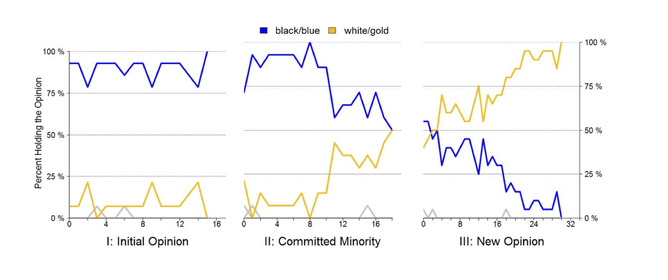Reports from the dress manufacturer now have revealed its true colours – a stylish blue and black combo – but this detail does not stop us from marvelling at how quickly public opinion was polarised between the two options (white and gold v black and blue).
Moreover, if the dress is blue and black, why did so many people think it was white and gold? Many have offered biological and neurological reasons why that was the case. But our research indicates that the emergence and polarisation of public opinion may be explained as an unintended consequence of people’s influence over one another.
Why do opinions spontaneously converge?
For the last decade, computer scientists, sociologists and even physicists have been trying to understand how vast segments of the internet seem to spontaneously converge on opinions. From beliefs about the safety of vaccinations to disagreement over climate change, popular opinions continuously emerge and evolve in unpredictable ways.
Most of what we know about this process comes from mathematical models and computer simulations. Such models, however, cannot account for the richness of human behavior, and thus fail to provide a satisfying explanation of how complex shifts in public opinion emerge.
Fortunately, new internet technologies have made it possible to experimentally study how hundreds or even thousands of people interacting simultaneously can produce new collective beliefs.
Recently, my collaborator, Andrea Baronchelli, and I conducted a Web-based experiment to see whether we could “grow” a large-scale shift in collective opinions.
Can shifts in opinion be manufactured?
For our study, published last month in the Proceedings of the National Academy of Sciences, we created an online naming game on our website, The Social Innovations Lab. Participants were placed into a large social network with other players, but were allowed to interact with only a small fraction of the other participants in their network.
Each time they interacted, their goal was to coordinate with other players in an attempt to agree on a word or idea. For instance, participants in some of our studies were shown a face and asked to choose a name for it. At the same time, another player would also choose a name.
Our aim was to see whether people would eventually start to choose names that would align with one another. The challenge was that each person was interacting with several other people, each of whom was also interacting with several others, and so on, making it very difficult for participants to figure out a common language.
What we found was surprising: If people were connected in local networks they could easily coordinate with their friends, but a popular opinion never formed. However, if participants were placed into networks where they interacted with more strangers, everything changed. After a few rounds of play, people who had never interacted before began spontaneously coordinating on the same opinion. Once this started happening, a dominant norm quickly emerged and almost immediately, everyone in the population achieved consensus.
These studies showed that the expansion of online social networks that provide people with greater access to new social contacts can impact not only the rate at which people converge on new public opinions, but also how democratic the process of opinion formation will be.
Manipulating opinions on ‘The Dress’
Enter The Dress. We wanted to know if it would be possible to manipulate the dominant opinion about the dress colour – for instance, getting everyone to coordinate on “black and blue”? More importantly, we wanted to know if we could then use a small minority of people to mobilise an alternative opinion (for instance, “white and gold”) and succeed in getting everyone to agree on the new norm.
Like a grassroots organisation with a mission, we wanted to see whether we could change the consensus view on the dress.
Using the same experimental design described above, we ran a study on March 3 to see whether changes in popular beliefs about the dress color could be mobilised by a small fraction of participants – creating a sweeping change in popular opinion about the colour of the dress.
In this experiment, we showed people the famous dress picture and let them choose from six different colour options, in random order, (black/purple; white/gold; white/tan; black/blue; black/gold; and white/blue). Immediately, the entire network converged with everyone saying “black/blue”.
We then assigned a quarter of the population to be confederates who changed their opinion to “white/gold”. At first, this minority was ignored, and the black/blue norm seemed immutable. However, after a few rounds of interacting with other players the minority began to gain traction, eventually causing a striking shift in the network. The norm went from complete agreement on “black/blue”, to half saying “black/blue” and half saying “white/gold”.
We continued the study to see whether any further changes in popular opinion would emerge. We found, remarkably, that the minority group was able to push their view to become the dominant opinion. By the end of the last rounds, everyone in the population was saying “white/gold”! The graph below illustrates this.

Patterns of opinion on the dress changed over time. Damon Centola
The remarkable power of social interactions to shape public opinion is surprisingly flexible. Large swells in coordinated beliefs can emerge as a simple function of people interacting with one another, without any leader or particular incentive driving people’s convictions.
But, what is even more surprising is that our studies show that as social networks become increasingly connected, it becomes much easier for a small vanguard of committed individuals to have a tremendous influence over this process, shifting the balance of public opinion from one perspective to its opposite.
This article was originally published on The Conversation.










